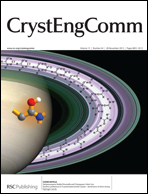Multi-functional d10 metal–organic materials based on bis-pyrazole/pyridine ligands supported by a 2,6-di(3-pyrazolyl)pyridine with different spanning flexible dicarboxylate ligands: synthesis, structure, photoluminescent and catalytic properties†
Abstract
A series of the novel zinc complexes, Zn3(H2L1)2(ox)3(H2O)2·4H2O (1), Zn(H2L1)(ad)·2H2O (2), Zn2(HL2)2(suc)0.5·(HCOO)·H2O (3), Zn2(HL2)2(glu)·2H2O (4), Zn2(HL2)2 (ad)0.5·(OH)·0.5H2O (5), Zn2(HL2)2(seb)(H2O)·2.5H2O (6), (H2L1 = 2,6-di(5-methyl-1H-pyrazol-3-yl)pyridine, H2L2 = 2,6-di(5-phenyl-1H-pyrazol-3-yl)pyridine, H2ox = oxalic acid, H2ad = adipic acid, H2suc = succinic acid, H2glu = glutaric acid, H2seb = suberic acid) were synthesized hydrothermally from the self-assembly of a Zn(II) ion with different types of the new bi-pyrazolyl pyridine derivative ligands and different spanning flexible dicarboxylic compounds as an auxiliary ligand. They were characterized by elemental analysis, IR and UV–vis spectroscopy, powder X-ray diffraction (PXRD) and single-crystal X-ray diffraction. We found that they are all molecular compounds using the above detections. The structural analysis indicates that the zinc atom in complex 1 is a six-coordinate mode of ZnO3N3, forming a slightly distorted octahedral geometry, while zinc atoms in complexes 2–6 are all penta-coordination modes of ZnO2N3 and ZnON4 in a distorted bipyramidal geometry. The H2L1 ligand is in the form of a μ1–η1–η1–η1 coordination with metallic Zn in 1 and 2; while the HL2 ligand is in a μ2–η1–η1–η1–η1 coordination mode in 3–6. For the oxalate ligand, there are two kinds of coordination modes, μ2–η1–η1–η1–η1 bridging coordination mode and μ1–η1–η1 terminal coordination mode; the coordination mode of glutaric acid ligand is in the form of μ2–η1–η1; suc2− ligand is in the form of a μ4-bridging coordination fashion with each side carboxylate group in a μ2–η1–η1-monodentate mode; the coordination of the adipic acid ligand presents two coordination modes of μ2–η1–η1and μ4–η2–η2; suberic acid ligand acts in a monodentate terminal coordination mode. In addition, thermal behaviors and photoluminescent properties for 1–6 were all performed and are discussed in detail. The catalytic activity of the complexes is evaluated firstly by the reaction of hydrogen peroxide promoted oxidation of cyclohexane and cyclopentane under mild conditions. It is found that the Zn complexes with five different spanning flexible dicarboxylic acids as an auxiliary ligand with oxalic acid, succinic acid, glutaric acid, adipate acid or sebacic acid, respectively, have potential catalytic activity in the oxidation reaction of cyclohexane.


 Please wait while we load your content...
Please wait while we load your content...